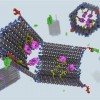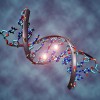Cancer-free mole rats may hold a key to fighting cancer.
 I was always under the impression that sharks never got cancer. It turns out that isn’t true – they do get cancer, but less often than people. There is an animal that doesn’t get cancer though, and that is the naked mole rat. These cute little creatures live long lives underground, so I’m not sure how anyone figured this out.
I was always under the impression that sharks never got cancer. It turns out that isn’t true – they do get cancer, but less often than people. There is an animal that doesn’t get cancer though, and that is the naked mole rat. These cute little creatures live long lives underground, so I’m not sure how anyone figured this out.
Needless to say, an animal that doesn’t get cancer is something worth studying. Why no cancer? It turns out that mole rat cells don’t “like” each other very much. Researchers discovered that when these cells are cultured, they stop dividing at lower cell densities than other cells. This growth arrest, which is called “contact inhibition”, is under the control of a gene called p16. When cells contact each other, receptor proteins sense the contact and activate p16. With p16 active, the cell cycle is inhibited. P16 acts very much the same way as p27, the gene that controls contact inhibition in people. Mole rats have p27 and p16. This double whammy keeps cells from growing too much, which is a hallmark of cancer.
Why this extra level of control? Mole rats live up to 30 years and continue to have offspring throughout life. This means that cancer could have an impact on their fitness. They also have another important difference from us. Most of the cells in us have a limited ability to divide. This is because the ends of the chromosomes, called telomeres, shorten every cell division. Once they are too short, the cells stop dividing. In mole rats, the telomeres don’t shorten. This is because mole rat cells express an enzyme, called telomerase, which lengthens the telomeres. Telomerase is usually activated in cancers, allowing them to divide without limit. Without a limit on the number of cell divisions by telomerase shortening, it seems that mole rats have evolved a different way to keep their cells in check.
The exciting thing is that we have p16, but it doesn’t seem to affect our cells the same way. If we can tweak cancer cells to react to contact like mole rat cells, we may be able to make them stop themselves!
The image of the mole rat was taken from the Animal Behavior Lab of Gray Lyons at Davidson College
| Print article | This entry was posted by Bruce Nash on January 11, 2010 at 10:43 am, and is filed under Inside Cancer. Follow any responses to this post through RSS 2.0. You can skip to the end and leave a response. Pinging is currently not allowed. |










